How to reach Everest Region
Located in the northeastern part of Nepal and Protected by Sagarmatha national park, the Everest region can be reached in different ways direct flights to Lukla from Kathmandu, Jiri, or Phaphlu are among the most common ways due to the unavailability of direct road links. Taking the bus to Jiri takes a 4-5 days trek and 2-3 days for Phaplu to enter the region.
About Lukla Flight
Lukla Airport (Tenzing-Hillary Airport) is a small domestic airport located in the town of Lukla in the Everest region of Nepal. It is considered one of the most dangerous airports in the world due to its challenging landscape, short runway, and changeable weather conditions.
There is no direct road connection to Lukla from Kathmandu, so all trekkers to get Lukla either have to fly to Lukla airport or trek from Phaplu or Jiri. There are many airlines that operate regular flights from Kathmandu.
There is a limited luggage weight for the Lukla flights. The 15 kg of the luggage weight is allowed to each passenger that also includes your hand carry bag. If you have more than 15 kg luggage weight, you have to pay 120 rupees extra per kg.
Please be responsive in taking a smaller aircraft for the flight to the highlands. Sometimes there will be delays or cancellations to the Lukla flight due to weather conditions but we try to do our best for the flights. That’s why you have to need 2 /3 extra days for Everest View Trek .
If the weather condition is really bad and you have a very tight program, you can charter a helicopter to complete the trip on time. The helicopter cost is the extra from the trip cost but needs minimum 1,500 meters visibility to operate the helicopter. We are always with you to assist in arranging the Helicopter to fly in Lukla.
Best Time to Everest View Trek
The best time to visit the Everest View Trek is during the two main trekking seasons namely pre monsoon (spring) and post monsoon (autumn) periods. These two seasons offer the most favorable weather and spectacular views, making your trekking experience enjoyable and memorable. We can do Everest View Trek throughout the year but the weather is quickly changeable during the summer and winter season, which makes it terrible to get to the target on time due to landslides and changeable weather.
-
Spring season (pre monsoon) - March to May
Spring is one of the best times for the Everest view Trek. During this season, the weather will be generally stable, with mild temperatures during the day and clear skies, providing excellent visibility of the surrounding mountains including Mount Everest, Lhotse, Nuptse, Aamadoblam and more. The trekking trail is decorated with vibrant rhododendron blooms, creating a colorful and picturesque landscape. The temperatures are pleasant, making it a comfortable time for hiking and the days are longer, allowing for more exploration. So, the spring is the best and recommended time for trekking and climbing in Nepal.
-
Autumn season (Post monsoon) - September to November
Autumn is another popular and recommended season for the Everest View Trek. The weather will be dry, and the skies are generally clear, offering breathtaking views of the Himalayan peaks. The temperatures are moderate, and the conditions are favorable for hiking. Autumn is also known as the post-monsoon season, so the air is crisp and clean after the rains, providing surprising vistas of the surrounding mountains and landscapes. You might have the opportunity to witness local festivals like Dashain and Tihar, which add a cultural touch to your trekking experience. While autumn is popular and can attract a higher number of trekkers, the atmosphere is generally lively and energetic.
-
Summer and winter season (July to August & November to February):-
Everest View Trek is possible during the summer and winter seasons but can be more challenging compared to the preferred trekking seasons of spring and autumn. Summer is not the most recommended time due to the challenging weather conditions and potential risks involved. Winter season can be suitable for experienced trekkers but you have to prepare for the cold conditions and have the appropriate gear and equipment.
However, the weather and trail conditions may not be as favorable and you may encounter more challenges, such as rain and snow during the winter months (December to February) and the possibility of monsoon rains and leeches during the summer months (June to August). This is not a good time for trekking in the Everest Region of Nepal including Everest View Trek.
Everest View Trek Difficulty
The Everest View Trek is considered a moderate-level trek, suitable for those with a reasonable level of physical fitness and some previous trekking experience. A moderate level of physical fitness is recommended for this trek. Regular cardiovascular exercise, strength training, and stamina training will help prepare your body for the difficulty of trekking at higher altitudes.
While it's not as strenuous as the full Everest Base Camp trek and other trekking routes in the Everest Region, but it has presented its own set of challenges due to the altitude and varying terrain.
The Everest view trek leads you ascend to higher altitudes, the air becomes thinner, which can lead to altitude-related issues such as altitude sickness. The Everest View Trek reaches a maximum altitude of around 3,900 meters (12795.28 feet) at Tengboche, where altitude-related symptoms can start to appear.
The Everest View trekking trail is well-maintained paths to rocky and uneven terrain. There are some steep ascents and descents, particularly in sections like the climb to Namche Bazaar and Tengboche Monastery. While technical climbing skills are not required, a good level of fitness and suitable footwear are essential to walk on the terrain comfortably.
The Everest View trek normally takes about 7-9 days to complete, depending on your pace and itinerary. Each day might require walking for 5-7 hours or more. The pace can be challenging, especially at higher altitudes where the reduced oxygen levels can affect your energy levels.
The weather in the Everest region can be changeable, even during the best trekking seasons. You might have chilly mornings and evenings, especially at higher altitudes.
Proper preparation, including physical training, understanding the itinerary, and being aware of the potential risks of altitude sickness, will greatly improve your trekking experience on the Everest View Trek. If you're unsure about your fitness level or any medical concerns, it's advisable to consult with a doctor or your trekking organizer before starting the trek.
Food, Water and Accommodation during the Everest View Trek
Teahouses or lodges are the main accommodation options along the Everest View Trek. These lodges are well managed with the availability of lots of accommodations and restaurants. These are basic but comfortable guest houses that provide rooms with beds, blankets, and sometimes shared bathrooms.
If you want to use luxury lodges along the Everest View Trek, there are also premium luxury lodges available in a few places. Every different place has different quality of the lodges and might become more basic as you gain altitude, so you can choose the best lodge for accommodations to your suitable budget. The Himalayan yeti home, Everest View Hotel and Everest Summit lodge are the luxury lodges along the Everest View Trek.
Every teahouses and lodges along the trek offer a variety of meals to keep trekkers nourished and energized. The food menu with nearly identical food items along the trek offer a variety of food options, including both local Nepali and more familiar western dishes. The cooks are essentially skilled, yet the meal may have a taste that differs from that of western cuisine.
Some common food items you might find are dal bhat (a traditional Nepali meal of rice and lentil soup), noodle soups, Momos, pasta, fried rice, pancakes, eggs, Potatoes and a range of snacks. While the food is usually hearty and satisfying, the meal options might become more limited and expensive as you go higher due to the logistical challenges of transportation. We advise you to try vegetarian recipes, because meat will be limited and not fresh in the mountains.
Drinking water is most important for staying hydrated during the trek in the Himalayas. You can purchase bottled water at tea houses but purchasing bottled water becomes more expensive as you ascend to higher altitudes. We recommended bringing your own reusable water bottle for drinking water during the Everest View Trek.
The cost of single bottle water can range from 100 to 500 Nepali rupees at elevated places. Reusable water bottles are beneficial to save costs and minimize plastic waste. You have to use water purification tablets or filters to treat water from local sources. This system is portable and effective solutions will enable you to treat water from local sources, which ensure safe and clean drinking water throughout the trek. Boiled water is also commonly available at tea houses but they charge a small fee and are a safer option. Our team will provide guidance on the proper usage of water purification methods, ensuring your hydration needs are met responsibly and economically during the journey.
Major Highlights of the Everest View Trek
-
Panoramic Mountain Views from the Everest view Hotel:
Everest View Trekking route doesn’t reach at the Everest Base Camp, but it offers breathtaking panoramic views of some of the world's highest peaks, including Mount Everest, Lhotse, Nuptse, Ama Dablam, Thamserku, and others snow peaks from the Everest view Hotel. Also the viewpoints along the trek provide some of the most beautiful and remarkable mountain vistas.
The Tengboche Monastery is a famous monastery in the Everest Region and it is one of the most important cultural and spiritual landmarks along the trek. This ancient monastery, surrounded by stunning mountain scenery, is a center of Sherpa culture and religious practices. Trekkers can observe prayers and ceremonies in the morning and evening during the Everest View Trek and others trek in the region.
-
Sherpa Culture and Villages:
The Everest View Trek is mainly inhabited by Sherpa people, known for their warm hospitality and rich cultural heritage. As you trek through Sherpa villages like Phakding, Monjo, Namche Bazaar, Khumjung, and Khunde, you'll have the chance to interact with locals, explore their unique way of life, and increase insights into their traditions and customs.
-
Sagarmatha National Park:
The Everest View trekking route takes you through some parts of the Sagarmatha National Park. It is a listed in, a UNESCO World Heritage Site known for its diverse flora and fauna. This national park area showcases the natural beauty of the Himalayas and allows you to experience the perfect environment of the region.
The Sagarmatha national park is famous for wildlife and known as home to a variety of animal species adapted to the high-altitude environment. While on the trek, you might spot some of the local wildlife, such as Himalayan thaar, musk deer, deer, pheasants, and various bird species.
Namche Bazaar is a busy Sherpa village located in the Everest region of Nepal at an elevation of around 3,440 meters. This exciting village is famous for its lively market, providing trekkers and locals with various goods. Namche is a center of Sherpa culture, offering monasteries, museums, and cultural centers that showcase the unique way of life of the Sherpa people.
Trekkers often spend extra days here to acclimatize before continuing on their journeys to Everest Base Camp and others journeys. The town's facilities include lodges, cafes, and bakeries, while its reliable internet and communication facilities allow trekkers to stay connected. In essence, Namche Bazaar is a dynamic and central destination that embodies both natural beauty and useful services for trekkers and adventurers exploring the Everest region.
Overall, the Everest View Trek provides an immersive experience that combines awe-inspiring mountain scenery with cultural interactions, making it a memorable adventure for trekkers of various backgrounds and interests.
Requires Permits & Permits Cost for the Trek
The Everest View Trekking route is situated within the Sagarmatha National Park in the Khumbu Pasang Lhamu Rural Municipality in the Everest region of Nepal. Therefore, you need to purchase a Sagarmatha National Park entrance permit and a Khumbu Pasang Lhamu Rural Municipality entrance permit. Another required permit is the TIMS (Trekkers Information Management System) card, which is for your safety and security, as it helps keep track of trekkers' whereabouts in the region. Both permits are mandatory for the Everest View Trek.
These permits can be obtained from a reputable trekking company, the Tourism Board (Bhrikuti Mandap), Kathmandu. The Sagarmatha National Park entrance permit can be buy in Monjo and Khumbu Pasang Lhamu Rural Municipality entrance permit can be purchased in Lukla after starting the journey. You or your guide must carry these permits throughout the trek, as you will need to show them and register at every checkpoint along the trail. If you attempt to trek without these permits, you will need to purchase them on-site at double the cost (as a penalty) or you may be forced to turn back.
- Requiring permits are given below:-
Khumbu Pasang Lhamu Rural Municipality entrance permits
- Cost: US$ 30 per person, per trek for all foreigners
- Cost: US$ 20 per person for SAARC (South Asian Association for Regional Cooperation) citizens
TIMS (Trekkers Information Management System) Card:
- Cost: US$ 20 per person, per trek
Sagarmatha National Park Entrance Fees:
- Cost: US$ 30 per person, per trek for all foreigners
- Cost: US$ 15 per person for SAARC (South Asian Association for Regional Cooperation) citizens
Cost for Everest View Trek
The cost for the Everest View Trek varies based on several factors, such as the trekking season, trekking agency you choose, starting and ending points of the trek, duration of the trek, group size, and level of service. This package is 10 days from your arrival to your departure from Nepal. For our 10-day itinerary, which covers the period from arrival to departure, the cost ranges from US$ 900 to US$ 1,500. This cost includes transportation, accommodation, food, guide, porter, and required permits for the trip.
However, the costs do not include emergency evacuation, drinks, snacks, trekking and climbing gear, or extra luxury accommodation. It is recommended to obtain detailed quotations from several reputable trekking agencies to compare and choose the best option that suits your needs and budget. We guarantee to provide reasonable costs and high-quality service for Everest View Trek within the above range. Additionally, we offer competitive and transparent pricing with no hidden costs, ensuring you get the best value for your money. Our packages include all essential services, making your planning and budgeting straightforward and hassle-free.
Luggage Load Carried by Porters during the Trek
If you are doing Everest View Trek with just a guide, it will be a cheaper journey, but the guide will not carry your luggage because they are professionals and have their own luggage to carry. In this case, you can hire a porter-cum-guide who handles both guiding and carrying your luggage, typically about 10 to 12 kg.
If you are in a group, we usually assign one porter for every two trekkers, so each trekker's luggage should weigh around 10 kg. If you hire a Porter, a porter typically carries 20 to 25 kg during the trek in Nepal. Trekking with both a guide and a porter highly recommended because they makes walking easier and gives you more free time to enjoy the trekking and climbing, resulting in a memorable trekking experience in Nepal during the Everest View Trekking.
Communication in the Everest View Trek
Good mobile phone coverage is available along Everest View Trekking route. However, coverage can be irregular or non-existent in more remote sections, especially at higher altitudes You can buy a local SIM card (Ncell or Nepal Telecom) in Kathmandu, which will provide coverage in many areas along the trek, though data speed and reliability may vary.
Internet services are available in many lodges along the entire journey. Teahouses and lodges provide internet access for an extra charge. However, in places like Lukla and Phakding the quality and speed are good, and they may offer it free of charge. Electric power sources are available in lodges, but they charge extra, so battery life can be a concern. Carry a portable power bank to keep your devices charged is highly recommended for this trip.
Tipping information
The trekking and climbing guide, as well as the porter, is essential to the success of the trip, ensuring that it is completed smoothly and without issues. Tipping is an important aspect of trekking in Nepal, as it acknowledges and appreciates the hard work of the local staff who assist you throughout your journey. It is customary to tip at the end of the trek, and you should gather all team members (guide, porter, assistant guide) together to distribute the tip. Tips are generally given in cash, preferably in US dollars or Nepalese rupees, and it is best to use small denominations to facilitate easier distribution
While the typical guideline is to tip around 10% of the total payable amount, you can adjust this based on the quality of service provided. Recommended tipping amounts are as follows:
- Guide: $12-$15 per day
- Climbing Guide: US$ 80 total
- Porter: $8-$10 per day
- Assistant Guide: $8-$12 per day
These tips are highly recommended to motivate the team and reward them for their outstanding service, contributing to a memorable and inspiring experience.
Acclimatization:
When traveling to higher elevations in the high Himalayan region, high altitude sickness is a regular problem. Although it develops fairly quickly, the symptoms can be avoided. If you have prior high-altitude trekking experience, it might be preferable, but if not, you should take precautions to avoid high-altitude sickness if you plan to walk over three thousand meters. In order to avoid altitude sickness while trekking in Nepal, you should walk carefully, drink enough water, abstain from alcohol, ascend higher, and sleep at low elevation. You should also spend two nights for every 500 meters over the elevation of 3500 meters. All of our trekking routes are adaptable and include days for acclimatization. Your health and safety come first so that you may complete the trek without incident. In case things worsen, we give you some essential medications to help with an emergency rescue.
As a result, you must advise your Guide or Leader of your health status each day. Based on his reaction, he will decide whether or not to let you continue on your trip.
Trip Extension:
After finishing the walk, if you have extra time, you can engage in other activities or go on another quick trek in Nepal. Chitwan National Park and Bardiya National Park for jungle safari excursions are only two of our many short travel packages and adventure activities. You can go sightseeing in Pokhara, go trekking in Nagarkot or Dhampus, or go rafting for the day on the Trisuli River.
Paragliding, kayaking, ultra light flight, bungee jumping, and mountain biking are examples of adventure sports. These are all optional add-on activities to your package that are not included in the price. If you choose to participate in these activities with us after your vacation, we will organize them at a fair price and give you a generous discount.
Trekking gear list
Before departing, you must pack your trip necessities. We hope it would be too much for you to transport from your country to another, but some of the necessary equipment may be rented or purchased in Kathmandu's Thamel area. While trekking in Nepal, this basic gear is appropriate for all seasons, though it may vary depending on the season and length of the trekking routes you choose to take.
1) Documents:
- Passport and 4 passport size photos
- Travel insurance details (in case an emergency evacuation if needed)
- Boarding passes for flights
- Driver’s license (if needed)
- Cash USD
- Credit/Debit Card (Ensure you have $500 on your card in case an emergency helicopter evacuation is needed)
2) Sleeping
- Sleeping bag (Comfort rating -15 Celsius recommended)
- Sleeping bag liner (Optional)
3) Footwear
- Trekking boots: one pair lightweight
- Sandals for city and tea house footwear
- Shoes for the plane and tea houses (Optional)
- Gaiters for hiking in winter to the base camp
- Thin, lightweight inner socks
- Thick, warm wool hiking socks
4) Clothing for Body
(Please make sure that you have non-cotton clothing for trekking)
- Base-layer t-shirts (e.g. running t-shirts)
- Fleece/Windproof jacket
- Waterproof jacket
- Down jacket for warmth
- Travel clothes and City Wear
- Underwear
- Base-layer trousers (optional)
- Waterproof trousers
- Trekking trousers
- Trekking shorts (Optional)
- Gloves and wool hat
- bandanna or scarf
5) Health Requirements (Basic First Aid Kit)
- First-aid kit; should contain lip salve, Aspirin, Band Aids, anti-histamine, Imodium or similar tablets for mild cases of diarrhea
- Re-hydration powder, extra prescription drugs you may be taking if any particular
- Wet wipes for cleaning can be purchased in Kathmandu
6) Others
- Sunglasses and Sun cream
- Towel
- Book (reading and writing materials)
- MP-3 /Music, headphones and ear plug (who know some people on group are snoring) as optional.
- Travel wash
- Hand sanitizer, wet wipes
- A day bag: 35 liters
- A duffel or rucksack with straps to go over your back (Max 12 kg of weight for porters to carry)
- Dry Liner or Dry Bag
- Water bottle/thermos/ camel bag: At least 2 L. Nalgen bottles best.
7) General Toiletries
- Toilet papers/ tissue
- Contact lenses, Glasses (if needed)
- 1 medium sized quick drying towel
- Tooth brush/paste (preferably biodegradable)
- Multipurpose soaps (preferably biodegradable)
- Nail clippers
- Face and body moisturizer
- Feminine hygiene products
- Small mirror
- On Personal Hygiene
- Wet wipes (baby wipes)
- Anti-bacterial hand wash
8) Others (optional)
- Trekking Poles
- Large plastic bags – for keeping items dry inside your kit / duffel bag
- Travel game i.e. chess, backgammon, and scrabble. (for luxuries)
- Binoculars (for luxuries)
- Trail Map/Guide book (if you are alone)


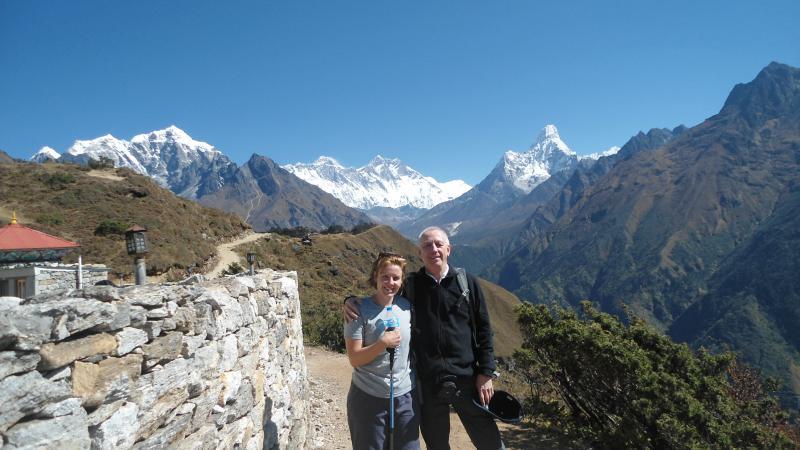
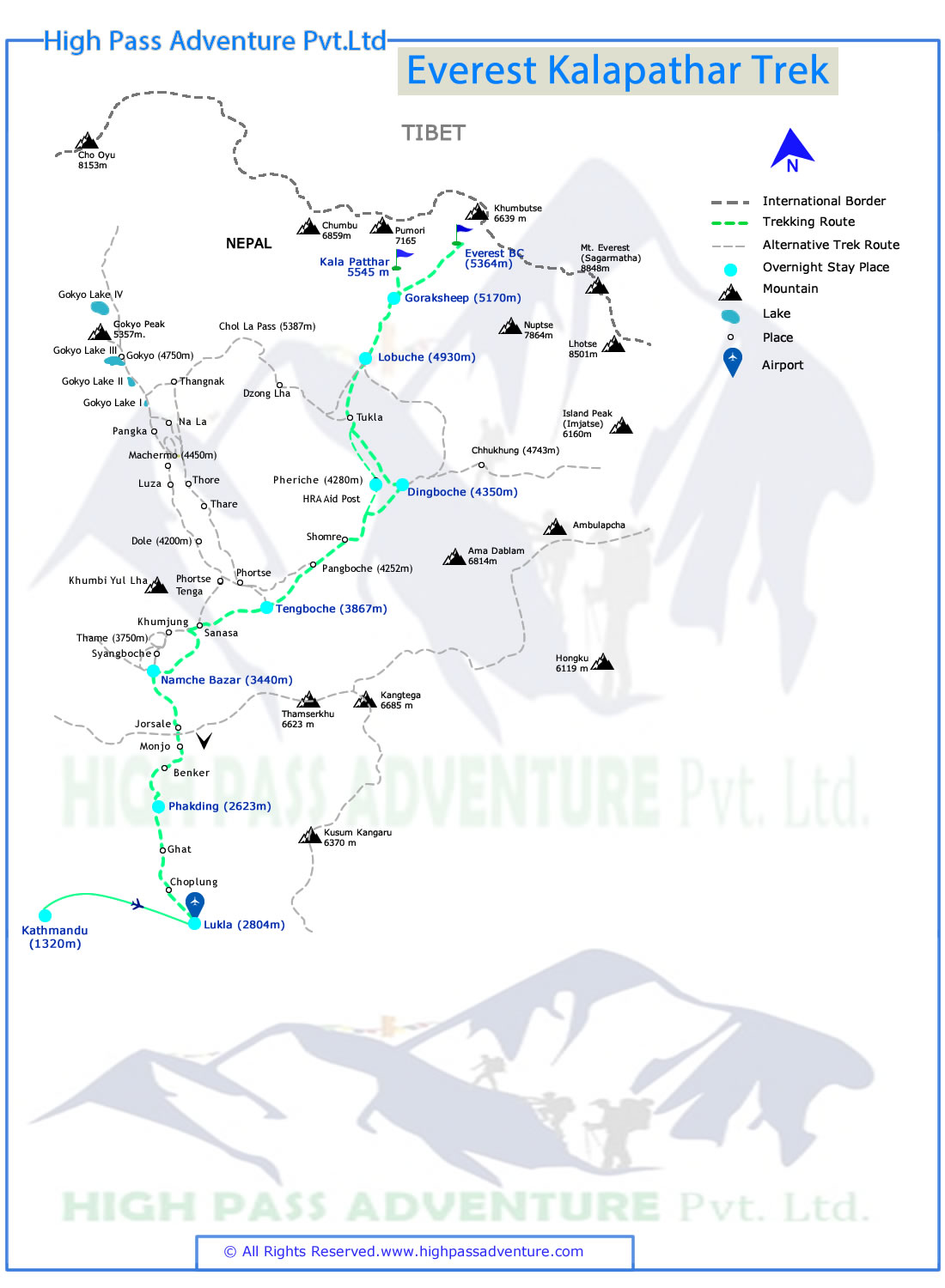




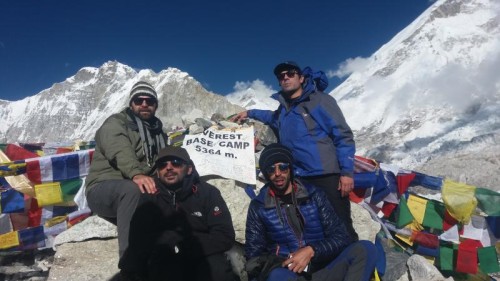
 USD 1340
USD 1340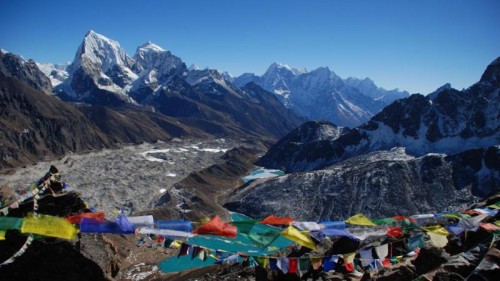
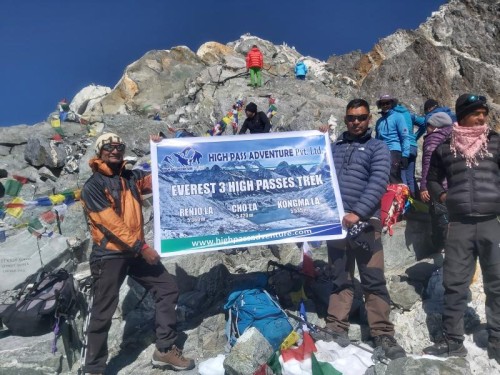
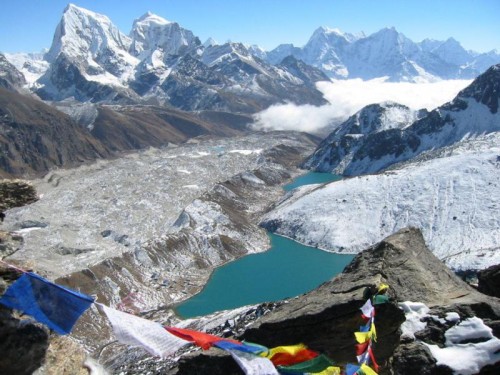
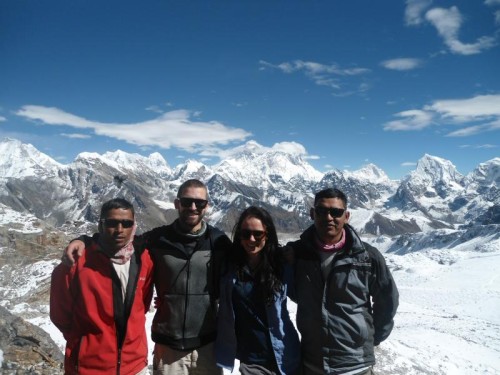

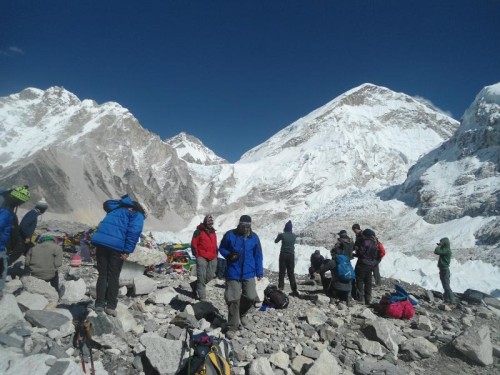
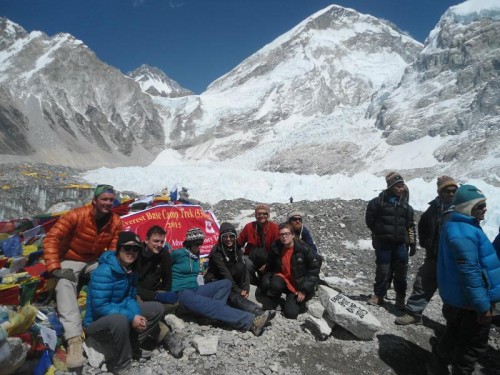

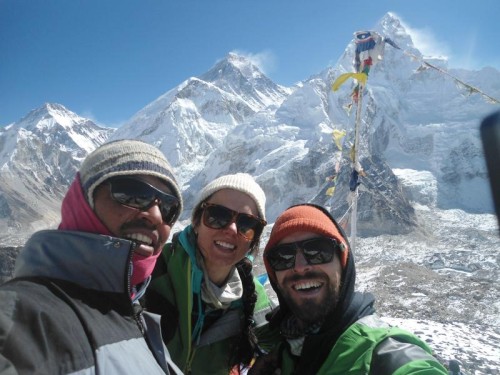
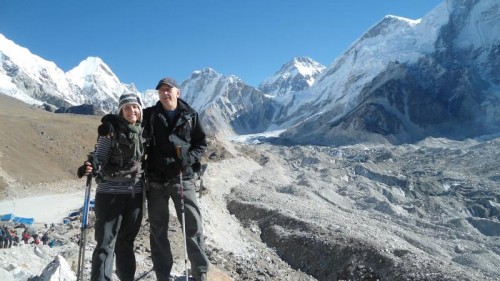
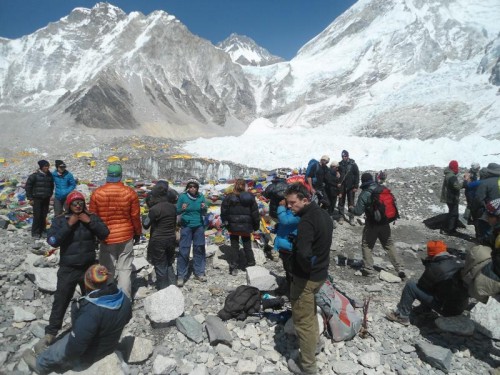
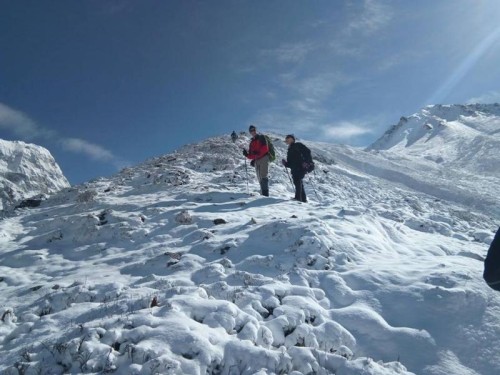

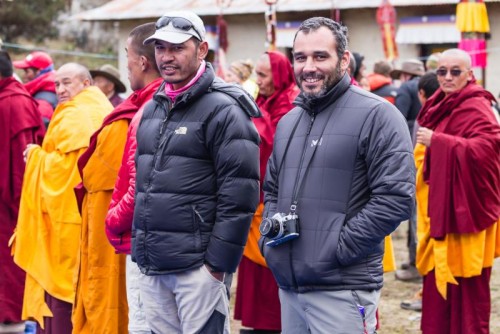
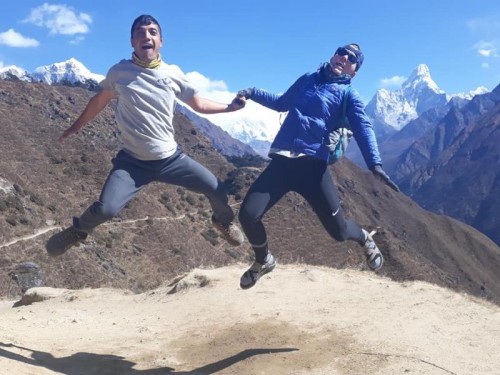

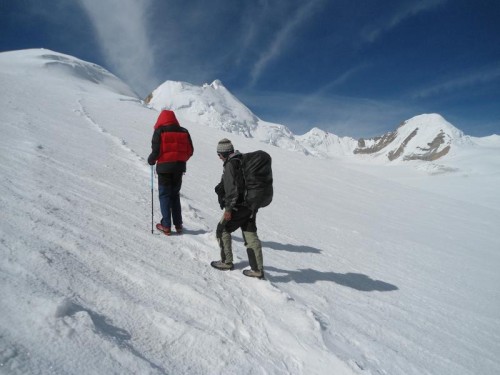
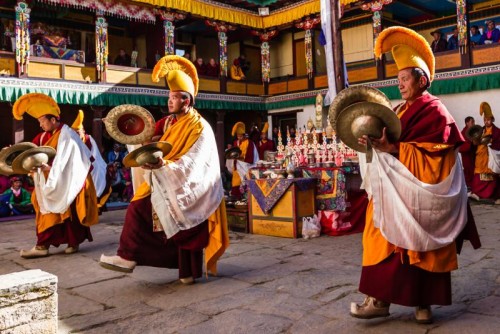
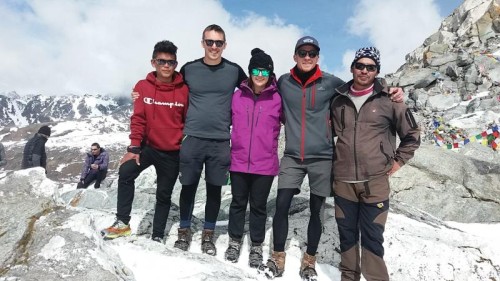

Tim and Wife
Australia
Wonderful Everest View Trek
13th June, 2023
Everest View Trek is a compartment of the Everest Region for those who have not got enough holidays to do the full Everest Base Camp trek. I did not have flight to Lukla from Kathmandu due to bad weather but our guide managed helicopter to fly out to Lukla.
Mark and friends
Spain
Wonderful experience in Nepal !!!
13th June, 2023
Our trip Planning was very simple easy with every question to Purna and fully answered about our plan. Our guide Gobhinda and porter was Pratap were the best ever kind, Knowledgeable and always friendly. We really enjoyed our time with them. We highly recommend High Pass Adventure. Again I will do next trekking with them. Thanks to Purna and his team